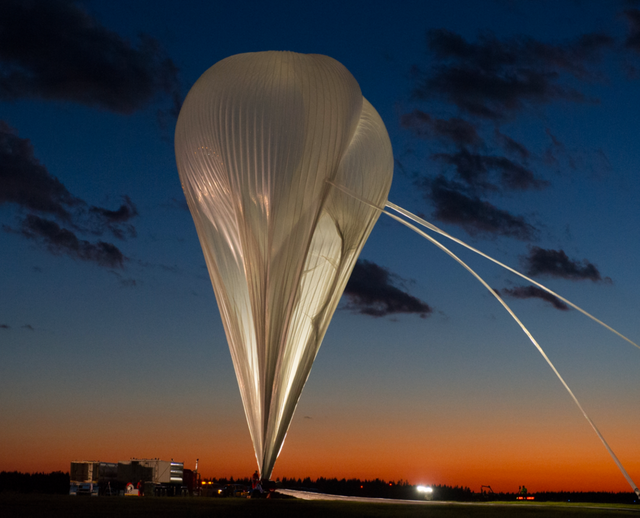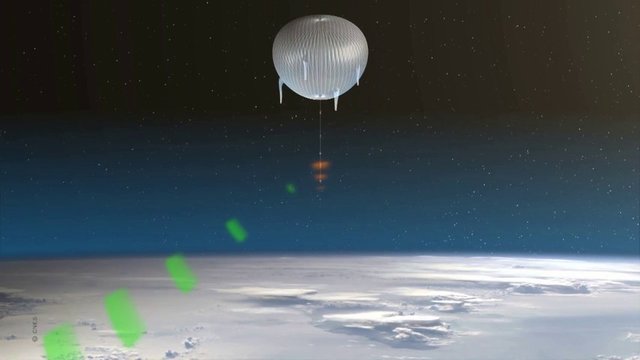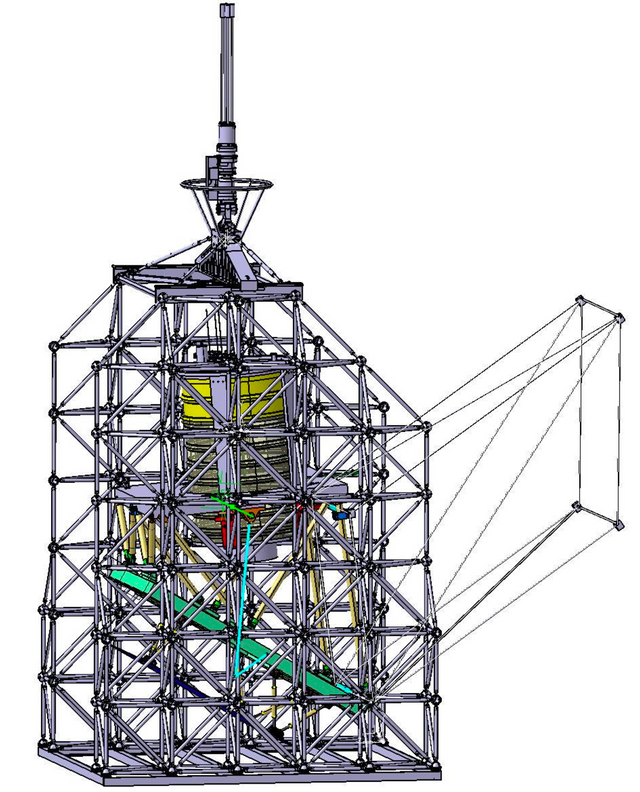Observing the universe with super large stratospheric balloons
With this post, I come back to astrophysics for a moment and will discuss stratospheric balloon experiments allowing for the observation of the universe. Yep, scientific experiments can also been handled with balloons. Not the birthday party version of the balloon, but the huge super-large one of course.

[image credit: CNES]
In particular, I will talk about the Pilot project which I have learned about by reading one of the recent CNRS news bulletin.
The news was about the last mission of the Pilot gondola, an instrument carried by a huge balloon of 170 meters of diameter.
This balloon recently carried out its second flight, where it has been allowed to observe, during more than 30 hours, the Australian sky. Or more precisely the Universe of the southern hemisphere lying way above the Australian sky.
The reason behind this project is tostudy the interstellar dust lying within our galaxy, and its magnetic properties.
WHY USING BALLOONS AS OBSERVATIONAL PLATFORMS
One of the major reasons to use stratospheric balloons to observe the universe is that they are way (way way way way way) cheaper than satellites, in this is true both to make them and to launch them. And as we all know, budget is a severe issue in science today…
Stratospheric balloons are then charged with plenty of scientific apparatuses that may depend on the scientific goal of the mission (infrared radiation, cosmic rays, etc.).
In addition, balloons allow to test in quasi-real conditions the technologies that will be used in space in the future. Stratospheric balloons are indeed reaching the stratosphere (no kidding, this is guessable from the name!), a layer of the atmosphere lying between 20 and 40 kilometers above the ground.
Although we are stil well within Earth’s atmosphere (we often consider the size of the atmosphere to be 100 kilometers height), the conditions in there are hard enough for these technological tests to be meaningful.

[image credit: CNES]
Now why sending balloons out to the stratosphere? First, because it is too high for an aircraft to reach it. So that if we want to get there, we need something else, like a balloon.
But why get there in the first place? Because it is actually one of the best place to observe the universe, at least under specific conditions.
The atmosphere of Earth blocks out part of the electromagnetic radiation from space, so that ground-based observatories are blind to it.
In other words, they cannot handle given radiation wavelengths, on which we want at some point to get information (see below to get some of the reasons).
In this way, launching, via a balloon, scientific instruments at high altitude in an environment where the air is rare (and thus not in the way of the measurements) will allow to get, in a kind of cheap fashion, information on the universe radiation pattern for wavelengths not reachable from the ground.
In short, these balloon projects may be considered as running observations in space, but without being in space (as the stratosphere is part of Earth).
THE PILOT PROJECT IN A FEW WORDS
The Pilot project is an international project aiming to send a balloon to space (with some scientific instrument on board), with a large French participation. This actually explains why I got information from the French CNRS news bulletin.
Once again, the name of the experiment is not random. We need to handle an abbreviation… Pilot stands for Polarized Instrument for Long-wavelength Observations of the Tenuous interstellar matter.
It targets the interstellar dust present in our galaxy and how this dust radiates. This study is complementary to what the Planck satellite did a few years ago. And this is the important key point.
Putting the information of both experiments together will allow to understand, on the one hand, the properties of the magnetic field of our galaxy (intensity, direction, structure, etc.), but also, on the other hand, the contributions of the interstellar dust.
And understanding better what is going on in our galaxy will allow to remove this as a foreground for the experiments trying to understand what is going on much further, at the level of the Cosmic Microwave Background for instance.
THE PILOT INSTRUMENT ITSELF

[image credit: CNES]
The Pilot instrument is shown on the left. Its weight is of about 1.1 ton, and one must lift it up until the stratosphere (at 40 kilometers high, said mentioned above).
In addition, the balloon has had to fly for more than 30 hours, which allowed by the way the apparatus to witness a day-night transition.
There is no one thousand different ways to achieve that with a balloon: as mentioned by some of you in the last steemSTEM physics challenge, one helium balloon is enough, provided it is large enough.
And by large, we here mean a balloon whose volume is 800.000 m3 and that is filled with helium. In terms of radius, it consists of a balloon with a radius of 75 meters. Nothing to do with the party balloons of the movie Up!, although as in the film and in the steemSTEM challenge, buoyancy is the physics principle behind.
Concerning the instruments boarded within the Pilot apparatus, they have been designed in a robust enough fashion, so that they have been able to observe the sky during the entire period (we need to make the best as we can out of them).

[image credit: CNRS]
The instrument contains a telescope (we want to observe the universe after all) made of an array of 2048 bolometers cooled down at a temperature of 0.3 kelvin degrees. A bolometer is a detector specific to the observation of infrared emissions.
It consists of cooled thermistors that will react to any temperature changes induced by, e.g., infrared emissions.
The rest is a matter of translating and amplifying the signal into something recordable by the electronics of the instrument.
THE LAST PILOT AUSTRALIAN MISSION
The last mission of the Pilot experiment happened last April, and is actually its second mission. The balloon left Australia early in the morning to landed roughly one day and a half later, 1000 kilometers away from its starting point.
It flew at an altitude of 39 kilometers during the day, and slightly lower (31-34 kilometers high) as induced by the natural cooling down of the helium (so that the lifting force is smaller) that has however been tamed down cleverly by some ballasts added to the balloon.
All the information recorded is currently being analyzed and a third flight, in Sweden, is being prepared for 2018.
Therefore, there is nothing much to be said yet… But we should stay tuned!
SUMMARY AND REFERENCES
In this post, I discussed the Pilot mission, an astrophysics experiment I have heard about for the first time last month. I introduced the concept of stratospheric balloons and I explained briefly how they work. While the mission is over now, the results are still being analyzed.
It is however already clear that they will allow for a better understanding of our galaxy and of our universe…
Extra pieces of information can be found here:
If the balloon did go up you'll see that The earth is flat and there are no satellites. Everything is done with towers and fiber optic cable run underground and water. Why cant we see any satellites from the ISS or any of the massive amounts of space junk? Do you have pictures from the balloon mission?
I am not working on this, so that the answer is no: I don't have pictures myself. You may want to browse the websites given as references. There are actually plenty of pictures available. What I can do on my side is to read the reports an the scientific findings (that I can actually understand since this is close to what I am myself working on). They make sense to me. These scientific publications are freely available and you can read to build your opinion out of them. You may however need to be patient for the new results. Scientists need time to digest them and write the articles.
The answer of the other question is in one word: 'scales'. The scale of the space junk pieces is tiny compared to the scale of the planet. The same holds for the satellites and the ISS. Their orbit is designed to prevent them from crossing each other. It is better to avoid collisions, isn't it? Just calculate the volume of the space junks, as well as the one surrounding the planet. You will see. To rephrase that: In the same way that if you flight sufficiently high, you will not be able to distinguish the very little details on the ground.
Excellent post @lemouth very much enjoyed this one :)
I am happy you did ^^
Baloon launched today! Let's see if the earth is a sphere or flat?
https://www.facebook.com/rick.hummer.1?hc_ref=NEWSFEED
@ironshield
I hope you will get nice results to share. I am however curious about how high your balloon could go.
Good time when i wanted to be an astronaut and explore the universe but end up being an accountant lol..
For this kind of experiment, there is no need to be an astronaut as everybody says on Earth (only the balloon flies a little bit).
Nice to see these instruments can be put on balloons. If we need expensive rockets to send instruments to space, the budget limits us to sending only a few instruments. And a few is not enough. There's tons of science waiting to be done. The universe is enormous, so much to discover!
Hopefully the altitude attained by the balloons is enough to use this approach to do many other astrophysics investigations beyond the magnetic field and dust in the galaxy.
It is more than enough. The idea is to reach the point where emission/absorption processes from the Earths atmosphere is minimum. And this is exactly 40 kilometers high. At the end of the day, we have an excellent astrophysics experiment at a very decent price :)
Of course, there is other stuff that is as interesting and for which one needs ground or space satellite and for which there is no way out... But balloons already do something :)
this post look an advance of steemStem physic challenge,
Kind of :)
and this is a great science
@lemouth a nice post though! am a student of medicine and don't know much of astrophysics but after reading your post i developed a little bit of incline towards physical science.as u have put your post in a very lucid and sweet language that i think made me understand astrophysics and resulting in developing an interest toward it ..
p.s if u want to follow me or view my blo do it at @naseerbhat
kindly upvote and follow
Astrophysics is actually much more vast compared to what I said in my blog post, but this is indeed a good start. Are you planning to write on medicine?
Do you guys think Da Vinci had calculated this kind of improvement ?
Is there a possibility to send/get informations with the equipment placed on the balloon(s)?
I think there is always a possibility of getting lost or destroyed;
would be a shame to invest and get nothing out of it.
Da Vinci had not calculated anything regarding the cosmological microwave background and all of that. This is much more recent. This being said, Da Vinci was a great man.
To answer the other questions: the equipment is built to resist the flight. No damage has been found after this mission and data is being analyzed at the time we speak (or write). This is however clear that damage can occur, even with all the undertaken precautions. For more information, I recommend having a look to the Pilot webpage I am referring to at the end of the post.
Well, after reading some dan brown books, i cannot think that there is an unknown aspect to his inventions.
I do not question his knowledge about measurement background etc. , but don't you think, he knew, that the day will come, when those balloons will reach greater heights and be helpful for mankind?
Ah ok, I misunderstood your comment. I thought you were discussing the astrophysics side, which Da Vinci was most probably unaware of. For the balloons, I don't know whether he has thought about such balloons (I really don't know), but that is possible/ Knowing the guy... :)
I always wondered about stratospheric balloons, well just cause I thought it'd be cool if I saw one pass from afar which is highly unlikely but no harm done hoping! You're apart of a bigger organization that runs these projects? Sounds pretty in depth. I mean I've some basic knowledge about engineering and aeronautics but I kinda lost you halfway. Informative stuff, maybe I'd catch up on some of your other write ups. Cheers! Keep em' coming.
#follow4follow
I am a researcher, but I am not an astrophysics experimentalist. I am a theoretical physicist, working on LHC phenomenology, dark matter, future colliders, etc... and I read a lot about my field (particle physics and astrophysics).
Engineering and aeronautics is great! Although it is definitely a bit far from what I write about ^^ What are you exactly doing?
I'm not doing currently. I'm planning to turn a single profile into a magazine like profile. Something with a whole lot of informative happenings in multiple categories till I can develop a following that's towards a certain type of genre of writing or sort? Just want to spread as much of information as I can to as many people as possible! I do realize it's really far apart haha! I'm so sorry about that. But as for the peasant like level that I am on in this category, I just find experiments like these pretty cool because you don't see them on a daily basis.
Cool!
The scale of these experiments is indeed way different from what could be done in a garage ^^
That's obvious! hahaha
Interesting new set of ideas! Following you amigo!